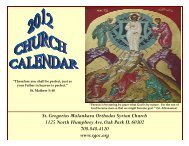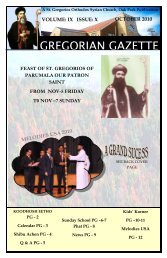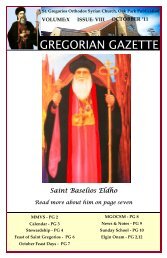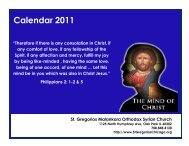GREGORIAN GAZETTE - St Gregorios Church, Elmhurst
GREGORIAN GAZETTE - St Gregorios Church, Elmhurst
GREGORIAN GAZETTE - St Gregorios Church, Elmhurst
Create successful ePaper yourself
Turn your PDF publications into a flip-book with our unique Google optimized e-Paper software.
A <strong>St</strong>. <strong>Gregorios</strong> Orthodox Syrian <strong>Church</strong>, Oak Park Publication<br />
VOLUME: IX ISSUE: IX SEPTEMBER 2010<br />
<strong>GREGORIAN</strong> <strong>GAZETTE</strong><br />
SEE BACK COVER PAGE<br />
SATURDAY SEP. 25 2010<br />
Feast of the Cross PG - 2 Q & A PG –5<br />
Kids’ Korner<br />
Calendar PG - 3<br />
Onam Elgin PG - 4<br />
“Love Christ, Hate<br />
<strong>Church</strong>” PG - 5<br />
Sunday School PG - 7<br />
Sunday School PG –7<br />
Onam Ward 9 PG - 9<br />
Divyabhodhanam PG - 9<br />
MMVS PG - 10<br />
PG -11<br />
Melodies USA<br />
PG - 12
PAGE 2<br />
Gregorian Gazette<br />
CHARACTERISTICS OF ORTHODOX CHRISTIAN SPIRITUALITY<br />
TRINITARIAN:<br />
I believe in one God, the Father All mighty, Maker of heaven and earth, and of<br />
all things visible and invisible; and in one Lord Jesus Christ, the Son of God,<br />
the Only-begotten, Begotten of the Father before all worlds, Light of Light, Very<br />
God of Very God, Begotten, not made; of one essence with the Father, by whom<br />
all things were made. I believe in the Holy Spirit, the Lord, and Giver of Life,<br />
Who proceeds from the Father, Who with the Father and the Son together is<br />
worshiped and glorified ... " [Nicene Creed]<br />
Look for more Characteristics of Christian Spirituality in the next issue of the Gazette!<br />
The Feast of the Cross<br />
Feast of the Cross is the commemoration of the finding of<br />
the cross of Christ by Empress Helen in the fourth century.<br />
The cross assumed special significance after its finding. The<br />
cross began to be venerated with reverence. Cross signifies<br />
Christ’s presence. It established our inheritance. We have to<br />
see the reality behind the cross – the crucified Christ. During<br />
the Sacrament of Marriage, we sing that the cross is the<br />
true sign of glory and the flag of victory and through the cross we are saved.<br />
Cross is a great positive sign. Our weakness when combined with the power of<br />
the cross becomes a great source of strength and releases great energy in the<br />
believer’s minds. <strong>St</strong> Paul states that in Galatians 6:14 ‐ May I never boast of anything<br />
except the cross of our Lord Jesus Christ.1. Cross reflects the reality of<br />
all human beings and their lives. It gives us hope in the midst of our trials and<br />
sufferings. 2. The cross is a wonderful source of power to overcome any force of<br />
evil – our weaknesses, sickness, material desires, etc. If the cross is with us, it<br />
gives us strength and fortitude. Let us pray that the cross of Christ be the energizing<br />
factor to help us in our walk with the Lord. Let us always rejoice in the<br />
cross of our Lord.<br />
Fr. M. K. Thomas<br />
Fr. V.M. Shibu<br />
Liju Paul<br />
Liju Varghese<br />
Elizabeth Varghese<br />
Gladstone Mammen<br />
George Panicker<br />
Joe Varghese<br />
Peter Varghese<br />
George Varghese (Publisher)
Gregorian Gazette<br />
September for Us PAGE 3<br />
12. Sunday — Fourth Sunday after the Ascension of <strong>St</strong>. Mary<br />
1 Peter 2:1-5, 1 Corinthians 3:16-23, <strong>St</strong>. Matthew 5:38-48<br />
First day of Sunday School 8.45AM<br />
14. Tuesday – Sleeba Perunnal (special service on Sunday)<br />
16. Thursday – 7.30PM Willow Brook Bible <strong>St</strong>udy<br />
18. Saturday – 9AM Holy Qurbana @ Elgin<br />
Prayer Fellowship Ward 4<br />
19. Sunday - First Sunday after the Feast of Holy Cross<br />
Acts 3:21- 26, I Corinthians 2:10-16, <strong>St</strong>. Mark 13<br />
MMVS meeting & Divyabhodanam after Holy Qurbana<br />
FOCUS Bible <strong>St</strong>udy<br />
Prayer Fellowship Ward 9<br />
21. Tuesday – Divyabhodhanam @ 7PM<br />
25. Saturday – Melodies USA Program @ 6.30PM Evanston HS<br />
26. Sunday – Second Sunday after the Feast of Holy Cross<br />
Acts 5:17-32, I Corinthians 2:14-3:9, <strong>St</strong>. Matthew 16:5-12<br />
Parent Teacher Conference<br />
Leadership Training @ church<br />
Oct 2. Saturday –Chicago Regional Teachers Training<br />
Oct 3. Sunday - Third Sunday after the Feast of Holy Cross<br />
Acts 7:2-5, Romans 8:1-11, <strong>St</strong>. Mark 2:23-28<br />
Divyabodhanam<br />
Oct 8. Friday - Skokie Bible <strong>St</strong>udy<br />
Oct 9. Saturday - MMVS Retreat<br />
Ecumenical Youth Retreat @ Mar Thoma <strong>Church</strong><br />
Leadership Training @ church
PAGE 4<br />
Gregorian Gazette
Gregorian Gazette<br />
Member Voice PAGE 5<br />
“Love Christ, Hate <strong>Church</strong>”<br />
Is <strong>Church</strong> relevant or necessary in today’s modern and educated world?<br />
A growing number of Christians think of <strong>Church</strong> as a man‐invented organization<br />
that often emphasizes rigid rules and customs above the teachings of Jesus<br />
Christ. Many struggle in reconciling what they see and experience on Sundays<br />
with “their own values, theological reflection and intuition”.<br />
To respond, one must first understand that early Christians never differentiated<br />
between Christ and the <strong>Church</strong>. One could never call themselves a follower<br />
of Christ without being a member of the <strong>Church</strong>. Even those who stubbornly<br />
refuse to look at ancient writings can find evidence of this unity of<br />
Christ and <strong>Church</strong> in Holy Scripture – to be a Christian meant to be part of a<br />
worshipping, liturgical community that shared a common Faith (e.g., Acts<br />
2:42). From Ephesians 5:30 ‐ “For we are members of His body, of His flesh<br />
and of His bones”, and earlier in Ephesians 2:19‐22 <strong>St</strong>. Paul teaches that we are<br />
“fellow citizens with the saints and members of the household of God” and<br />
makes the comparison to a spiritual building that “being fitted together grows<br />
into a holy temple in the Lord”. We believe and profess regularly in the Nicene<br />
Creed that this is the One, Holy, Catholic and Apostolic <strong>Church</strong>.<br />
Christ clearly identified Himself as One with this fellowship ‐ in Acts 9:1‐6, the<br />
resurrected Christ confronts Saul (who had been persecuting the early <strong>Church</strong>)<br />
on the road to Damascas with the words, “Saul, Saul, why are you persecuting<br />
Me?”. Later He emphasizes ‐ “I am Jesus, whom you are persecuting”.<br />
But, in order to understand the depth of this unity of Christ and <strong>Church</strong>, we<br />
need to appreciate that this relationship is not in the manner of master and<br />
slave, but rather an icon of the Holy Trinity. As H.G. Geevarghese Mar Osthathios<br />
explained, the basis of our Christian theology is in the Holy Trinity.<br />
Arguably, it is the misunderstanding of the Trinity that has created the confusion<br />
and questions we see today in these modern times. A possible explanation<br />
is the difficulty in accepting that, as created beings, we simply can never<br />
understand or explain the mystery of the Holy Trinity i.e., Father, Son and Holy<br />
Spirit being individual persons and yet one God.<br />
In the words of <strong>St</strong>. Gregory of Nyssa, "anyone who tries to describe the ineffable<br />
Light in language is truly a liar ‐ not because he hates the truth, but because<br />
of the inadequacy of his description”. Although the Trinity is neither<br />
rational nor scientific, we know this is truth. As early as the Book of Genesis<br />
(verse 26) we see the Triune God i.e., “Then God said, “Let Us make man in Our<br />
image, according to Our likeness””. The prophet Moses was not having a senior<br />
moment , but rather had intentionally used the singular form
PAGE 6<br />
Gregorian Gazette<br />
FROM PG 5 ‘God’ in the same sentence as plural pronouns ‘us’ and ‘our’.<br />
This is the beautiful and mysterious relationship of unity that permeates<br />
throughout the <strong>Church</strong> ‐ Christ and the <strong>Church</strong> are One, we (man and woman)<br />
are One with Christ, and we are One with the <strong>Church</strong>. As we read in Ephesians<br />
5:32 ‐ “This is a great mystery, but I speak concerning Christ and the <strong>Church</strong>”.<br />
The word ‘Sacrament’ is another word for mystery, and it is the Sacramental life<br />
of the <strong>Church</strong> that transforms us to be like Him.<br />
Therefore, instruction from the <strong>Church</strong> should not be understood in legal or<br />
ritualistic terms, but rather as guides from Christ to nurture and grow the fruit<br />
of the Holy Spirit (Galatians 5:22‐24) that is within us through the Sacrament of<br />
Holy Baptism.<br />
As an example, fasting should not be understood as punishment or dietary restrictions.<br />
Rather, just as Christ had fasted for spiritual strength (Matthew 4:2),<br />
as His One Body we should gladly fast together to gain spiritually strength.<br />
Through the fellowship and indwelling of the One Spirit in each of us, our individual<br />
sacrifice mysteriously strengthens the whole <strong>Church</strong> and this manifests<br />
as increased prayer and charity. It is not coincidence that major Feasts such as<br />
Easter and Christmas are preceded with Lent.<br />
And, if we take a second look we once again see the icon of the unity of the<br />
Trinity in this – although it was the Father who instructed the Son and sent<br />
forth the Holy Spirit, in no way did this diminish the One True Triune God.<br />
When the <strong>Church</strong> takes on the role of an instructor, in no way does our obedient<br />
response diminish the Trinitarian understanding that we are One Body.<br />
Our practice of praying for the departed also stems from this understanding of<br />
One Body – as we know Christ is eternal, we therefore better understand that<br />
our unity in Him does not stop when we die. As an aside, this is why in Orthodox<br />
weddings we do not hear the couple consenting that marriage is until<br />
“death do us part” since Holy Marriage is the Sacrament that brings together<br />
man and woman as One in Christ (Ephesians 5:22‐33) and death is never a separation<br />
from the Divine. Again, when we look at praying for the departed using<br />
the icon of the Holy Trinity, we see the aspect of eternal unity and therefore<br />
continue praying as if they are alive.<br />
To summarize – “To say we love Christ, who is the Head of the <strong>Church</strong>, and at<br />
the same time reject His body is to deny the New Testament teaching”<br />
(Orthodox <strong>St</strong>udy Bible , pg. 1604) .<br />
“There is one body and one Spirit, just as you were called in one hope of your<br />
calling; one Lord, one faith, one baptism; one God and Father of all, who is<br />
above all, and through all, and in you all” (Ephesians 4:4‐6).
Gregorian Gazette<br />
PAGE 7<br />
Q1: (submitted through <strong>Church</strong> suggestion box) Why does the Achen only give<br />
to the Holy Qurbana to the mouth rather than the <strong>Church</strong> member's hand?<br />
More people will take the Qurbana if people are given the option to take the<br />
bread as they prefer<br />
A1: The Holy Qurbana (a.k.a. Eucharist or Communion) is a Sacrament where<br />
those who are baptized in the <strong>Church</strong> eat the Holy Body and Precious Blood of<br />
Jesus Christ. This is not symbolic, but the real Body and Blood of<br />
Christ. Isaiah's vision of heaven (Isaiah 6:1‐7) is one that most closely resembles<br />
an Orthodox Liturgy, and verses 6 and 7 truly summarize the reverence<br />
that must be given i.e., "then one of the seraphim was sent to me. He had a<br />
live coal in his hand, which he took with tongs from the altar. He touched my<br />
mouth and said, "Behold, this has touched your lips. Your lawlessness is taken<br />
away and your sin is cleansed"". The practice in the West has become more<br />
casual towards this Holy Mystery, but in the East the reverence is still given<br />
and hence what we see on Sunday. After receiving the Body and Blood, we<br />
should be transformed and our very mouth that received the Mystery should<br />
then in turn only be used for the Word that is now within us. The point is not<br />
to give the Holy Qurbana to as many people as possible, but rather for as many<br />
people to transform and understand the true teaching and become One with<br />
Christ ‐ we must change our thinking and habits to become like Him.<br />
The new academic year of the Sunday School starts on<br />
Sunday, September 12 in the morning at 8.45<br />
am. Registrations for new students are now going on. Please register all new<br />
students to enable us to plan for an efficient start. The kick off and cook out<br />
held on Aug 28 Sat was well attended. The neighborhood had a block party and<br />
that helped as we did not have to worry about traffic and the children could<br />
play. We thank and appreciate the graduating class (Senior class) for coordinating<br />
and organizing the program and activities and the parents for purchasing<br />
the food stuff, organizing the cooking and helping with the cleaning. It was a<br />
blessed experience for the <strong>St</strong>udents, Parents and Teachers who attended.<br />
We are scheduled to hold the first Parents Teachers Meeting on Sunday, September<br />
26 after the Holy Qurbana. Mathew Koshy Achen, the Director of Sunday<br />
School, South West Diocese is scheduled to lead a Teachers Training and<br />
Workshop for Chicago Region on October 2, Saturday from 9.00 am to 4.00<br />
pm. Please reserve the date and time.
PAGE 8<br />
Gregorian Gazette<br />
Youhanon Mar Athanasios Episcopa was born on<br />
the 21 st of March 1928 to Varkey and Annamma of<br />
Chakkalaparambil Family in Kottayam. He attended<br />
CMS College where he worked as a lecturer<br />
in a college and resigned from there to join the Bethany<br />
Ashram. After joining, he was sent for higher<br />
studies in theology at Merphildil in England. He<br />
was ordained as priest in June of 1956 by H. G. Dr.<br />
Mathews Mar Athanasios.<br />
Aboon Yuhanon (1965-1978) served as the superior of Bethany Asram.<br />
He was known as a great retreat father of the time. Baselios Mar Thoma<br />
I Mathews Catholicos of the East consecrated him as Youhanon Mar<br />
Athanasios at Pazhanji <strong>Church</strong> in May of 1978. Ordained with five others,<br />
he was the youngest bishop of the time. He became the assistant<br />
Metropolitan of the Kottayam Diocese.<br />
He entered his eternal abode on October 2 nd , 1980. Mar Athanasios Episcopa<br />
was laid to rest at Perunad, Bethany, as he was a member of the<br />
Ashram.<br />
REV.FR.IDICULLA.M.CHANDY<br />
VICAR ST.THOMASBETHANY ORTHODOX CHURCH,<br />
idiculam2001@yahoo.co.in 0091-4735-227428<br />
Please contact Achen it you would like more information.<br />
Ward 9 Onam<br />
On Monday, September 6th, the families of Ward 9 gathered together at the<br />
home of Peter& Lilly Varghese for their annual Onam celebration. Most of the<br />
ward members were able to come out and enjoy a time of fellowship, fun and<br />
delicious traditional Onam food. There were also friendly games of tug‐of‐war<br />
and musical chairs, enjoyed by both the parents and kids alike. Many thanks to<br />
everyone who contributed to the lovely meal, to Peter and Lilly Varghese for<br />
opening up their home and to everyone who came out!<br />
(see pictures to the right)
Gregorian Gazette<br />
Divyabodhanam<br />
PAGE 9<br />
Divyabodhanan students had our usual Sunday class on August 22 nd with a surprise<br />
twist. The class celebrated Onam with full regalia for the first time for the<br />
class and (perhaps for the last time as a class as we are planning to graduate in<br />
2011). We had all vegetarian food served on customary Banana leaves starting<br />
with parippu and ending with payasam. It was a real cooperative event both in<br />
literal and figurative meaning. All students pitched in cooking and bringing all<br />
16 vegetables. The students, the teacher Shibu Achen and other church members<br />
served and sincerely participated and made it a great event. I thank all<br />
those who helped and participated in this Onam celebrations.<br />
May God Bless You,<br />
Marykutty Mathews— Coordinator<br />
Ward 9 Onam
PAGE 10<br />
Gregorian Gazette<br />
FROM PG 11 : 2)Thanksgiving (Eucharist) 3) Breaking of Bread 4) Remembrance and 5)<br />
Communion. Remember that the word for thanksgiving, “eucharista” became the name<br />
for the Liturgy, and the Greek word “Litourgia” meaning “work for the people” came to<br />
be the name for this sacrament. The Apostles did continue this practice and spread it<br />
throughout the early <strong>Church</strong>es. They continued in the truth that the center of Christian<br />
worship is to receive the Body and Blood of our savior.<br />
Early Liturgy<br />
It is apparent from early passages in the Bible that the Apostles did replicate the events<br />
of the Last Supper each time they gathered in Jesus’ name. The book of Acts and the<br />
Epistles (letters from the Apostles to the <strong>Church</strong>es) all show that they did this. The first<br />
Christians celebrated Divine Liturgy in the evenings, just as Jesus had. The services were<br />
simple, having a prayer service and an “Agape” (love) meal. The prayer service has Bible<br />
readings, narrations of Jesus’ teachings, prayers of thanks and the words Jesus told the<br />
Apostles “Take eat: this is my body. Drink of it all of you; for this is my blood of the New<br />
Covenant.” Everyone at each Liturgy would receive Holy Communion. It is plain from<br />
early writings that the meal was never thought to REPRESENT Christ, but was always<br />
thought of as being His actual Body and Blood. The early <strong>Church</strong> grew rapidly, and they<br />
soon began holding Liturgy in the morning and having the common meal in the evening.<br />
From the time of the Apostles to the 100’s, we don’t have a written record of exactly<br />
how Christians celebrated the Liturgy, but we do know they held it on Sunday morning<br />
and followed the 5 points of the Last Supper. Very early in this time a special prayer was<br />
added asking the Holy Spirit to bless the faithful and make the change of the bread and<br />
wine into the Body and Blood of Jesus. Its important to remember the amount of persecution<br />
the early Christians had to go through.<br />
MMVS monthly meeting was held on August 22nd and the discussion was on virtues of<br />
Godly women. We discussed two virtues of Godly women ‐ 1) Godly women are loving<br />
and caring 2) they have the ability to discern. The two women we compared were Eve<br />
who talked to a fallen angle. She listened to this angle and did not question her action<br />
and Mary who talked to a godly angle and she questioned. But that was a question of<br />
discernment (Luke 1: 34). We as Godly women should have the ability to question our<br />
action with prayer and in humility. Love of a mother is unconditional. Colossians 3: 12‐<br />
14 and 2 Peter: 11‐15 does have further reference to certain virtues like compassion,<br />
humility, gentleness, patience, forgiveness and love.<br />
A regional MMVS retreat was held on Saturday, September 4th at <strong>St</strong>. Mary’s <strong>Church</strong><br />
with Dn. James Cheriyan from <strong>St</strong>. Tikhon’s Seminary as the main speaker. It was a great<br />
blessing for all who attended. Thanks to James Semassen for taking time to be with us<br />
and to the MMVS members of <strong>St</strong>. Mary’s for opening up their parish..
Gregorian Gazette<br />
PAGE 11<br />
The Divine Liturgy<br />
Liturgy and us<br />
Each week as Christians, the Divine Liturgy is the highlight of our lives. Does this<br />
sound silly?<br />
Why do so many roll their eyes at the thought of attending <strong>Church</strong> Sunday morning?<br />
Perhaps we<br />
do this by not understanding what the Liturgy is, where it came from and what it<br />
means.<br />
The Liturgy is crucial to us because of the Sacrament of Holy Communion (Holy<br />
Eucharist). ForOrthodox Christians Eucharist is absolutely necessary for salvation.<br />
Where Divine Liturgy Comes From<br />
For many <strong>Church</strong>es today Sunday worship is a modern celebration featuring loud<br />
music resembling a concert. Orthodox Divine Liturgy is very ancient, actually being<br />
modeled after the Last Supper.<br />
The Last Supper had a special blessing and significant events:<br />
Jesus blessed, gave thanks, broke bread and offered wine. He also commanded the<br />
disciples torepeat these activities. This is very different from the other suppers that<br />
the Apostles had with Him. If you look at this really hard, you’ll see five things happening:<br />
1. He blessed<br />
2. He gave thanks<br />
3. He broke bread and offered it with the cup<br />
4. He commanded His Disciples to repeat what He did<br />
5. He invited the Disciples to eat the bread as His Body, and the wine as His Blood.<br />
These five things are the basic parts of our Divine Liturgy; 1) Blessing,<br />
SEPTEMBER BIRTHDAYS<br />
CONTD PG10<br />
9‐03 John, Akash<br />
9‐06 Mathew, Tejus<br />
9‐06 Geevarghese, James<br />
9‐10 Isaac, Jibi<br />
9‐10 Oommen, Alex<br />
9‐11 Poozhikunnel, Anand<br />
9‐14 Thomas, Anandu<br />
9‐15 Skariah, Midhu<br />
9‐15 Joseph, Jennifer<br />
9‐15 Easo, Kailash<br />
9‐16 Mathew, Binta<br />
9‐17 Chacko, Joel<br />
9‐18 Koshy, Paul<br />
9‐19 Jacob, Jisha<br />
9‐22 Kurian, Prejil<br />
9‐22 Varghese, Joju<br />
9‐22 Mathew, Tina<br />
9‐23 Panicker, Alex<br />
9‐26 Varghese, Renita<br />
9‐27 Joseph, Nathan<br />
9‐29 Isaac, Jodi
PAGE 12<br />
Gregorian Gazette<br />
Published By Rev. Dr. M. K. Thomas Library,<br />
<strong>St</strong>. <strong>Gregorios</strong> Orthodox <strong>Church</strong>,<br />
1125 N. Humphrey Ave, Oak Park, IL 60302<br />
Tel: (708) 848.4120 Web: www.1church.org







